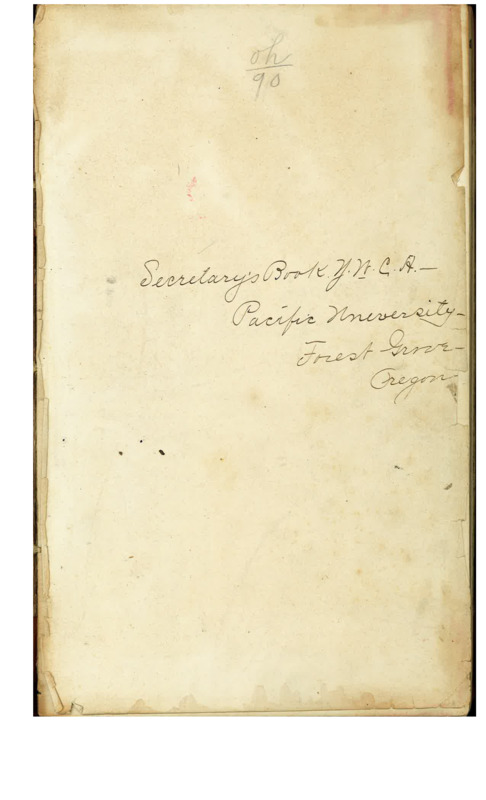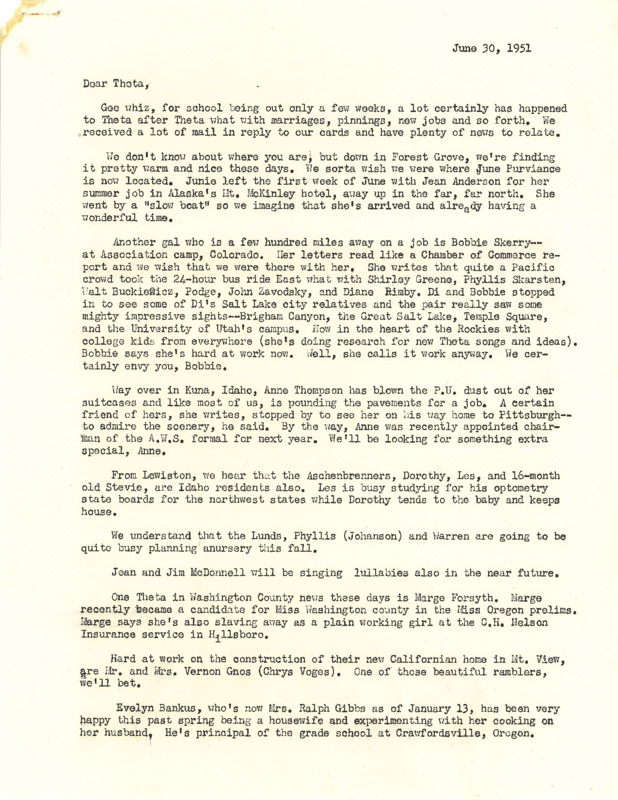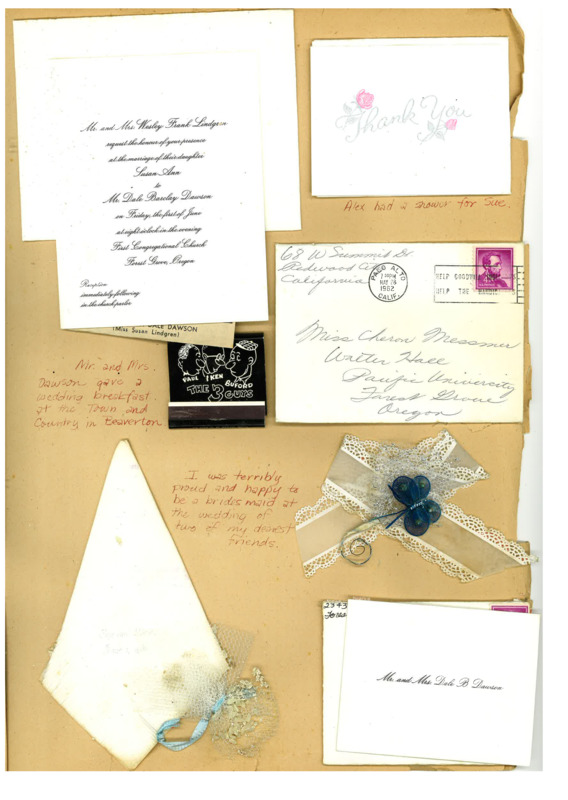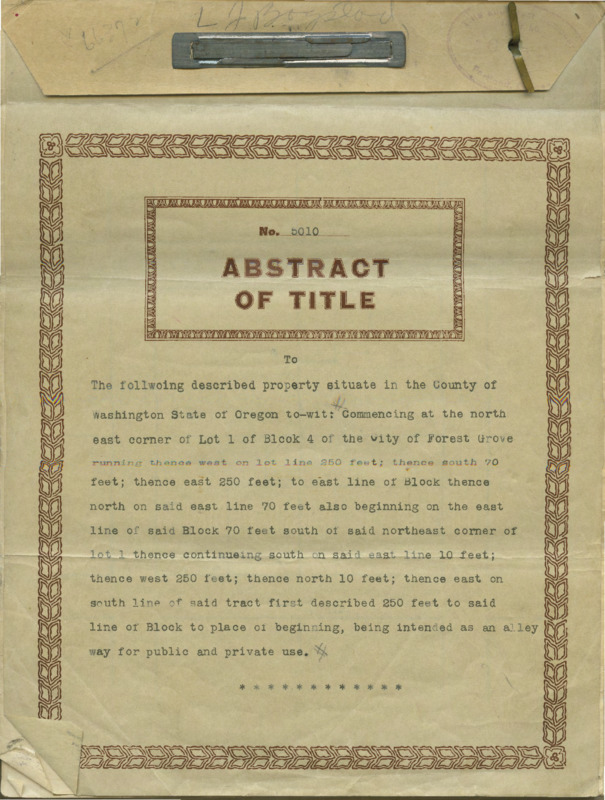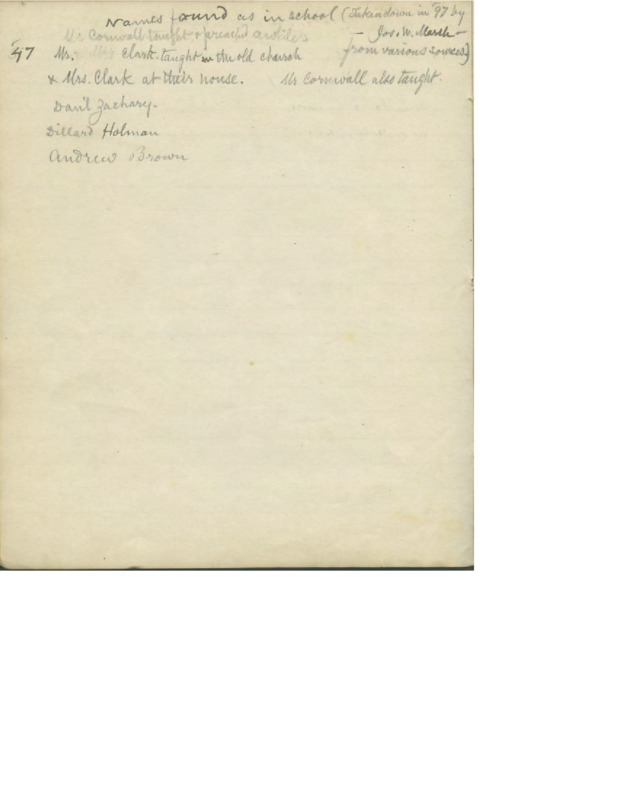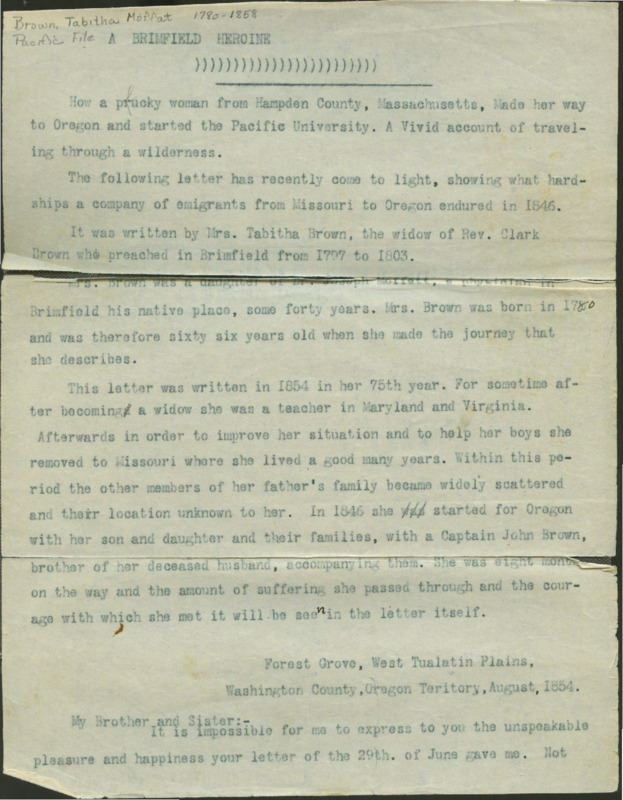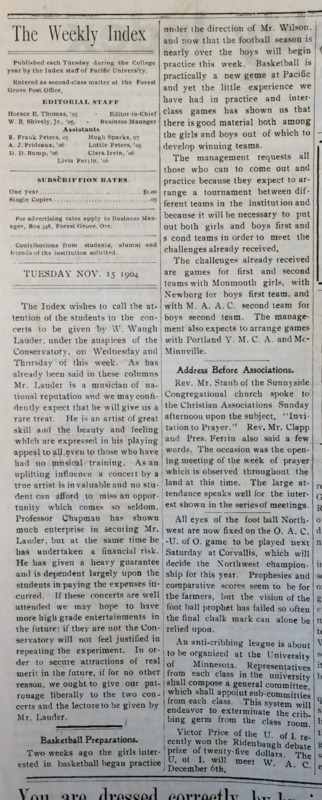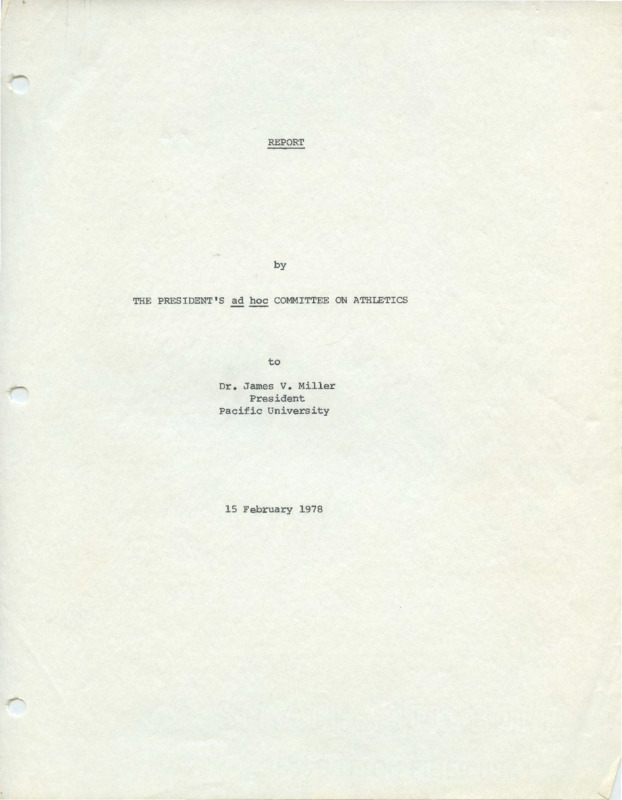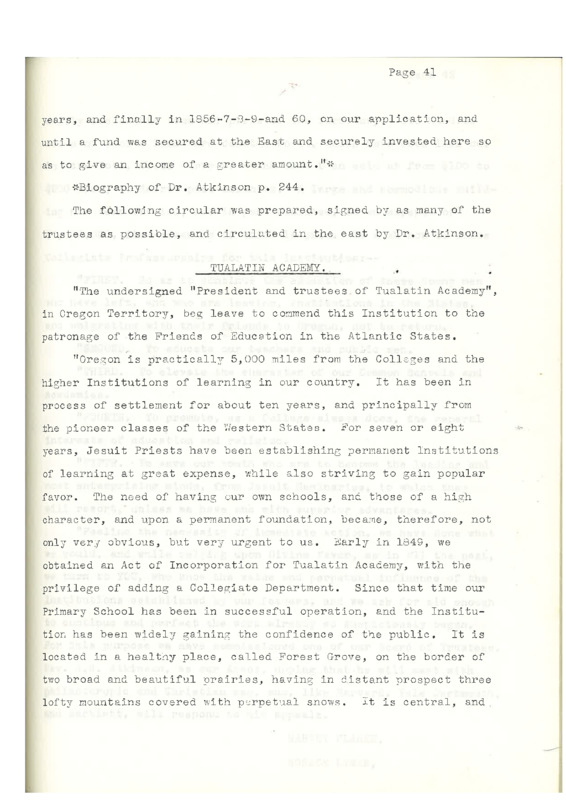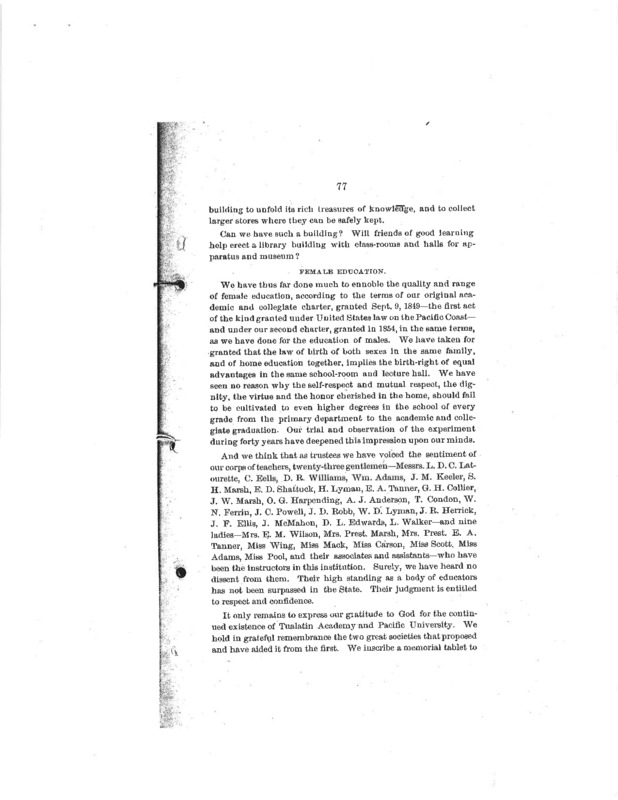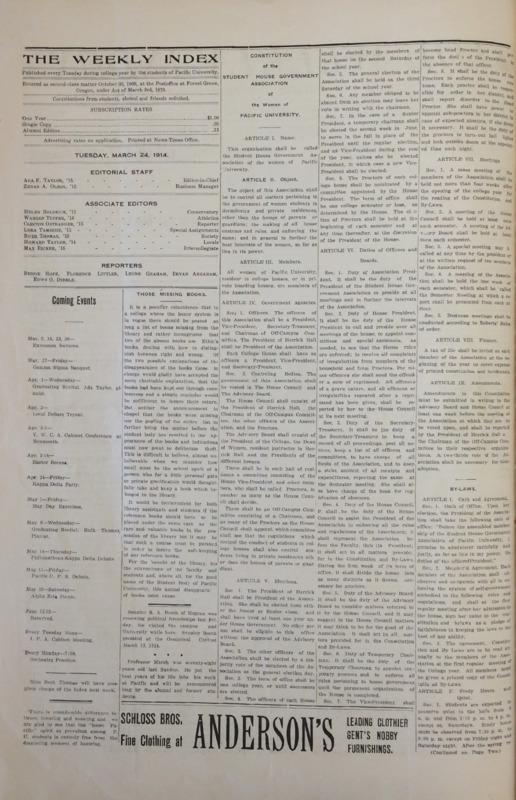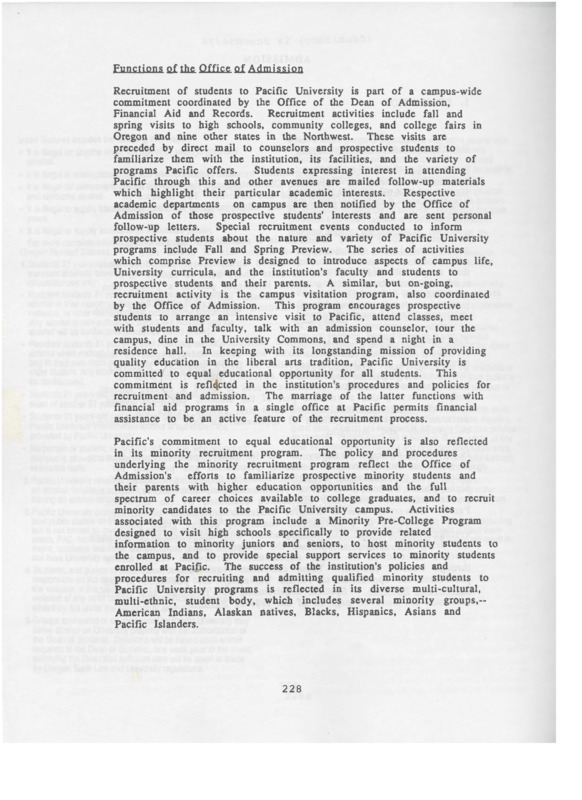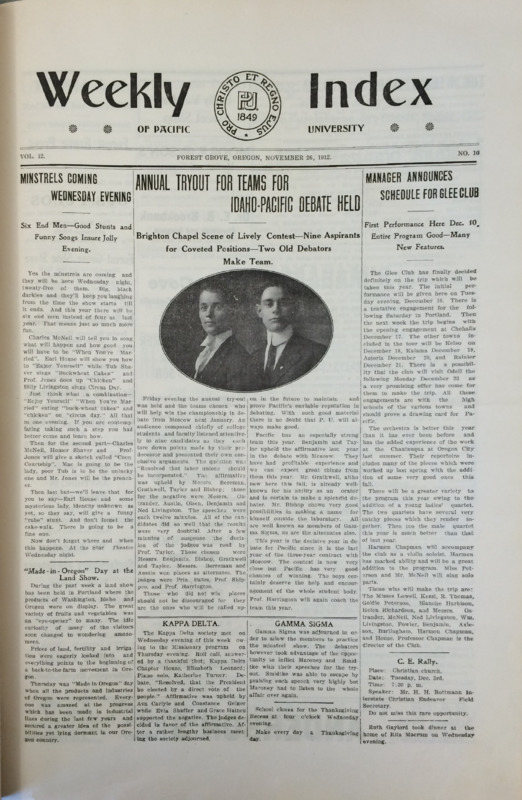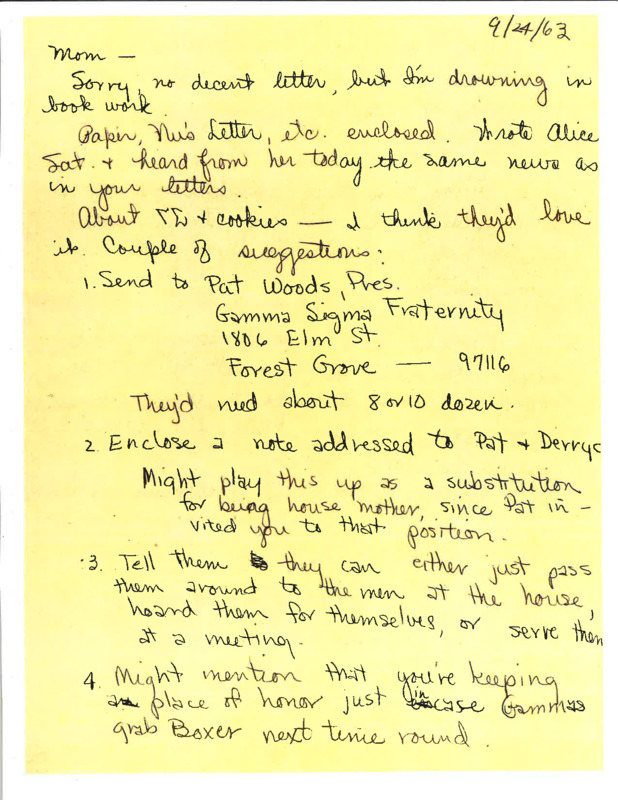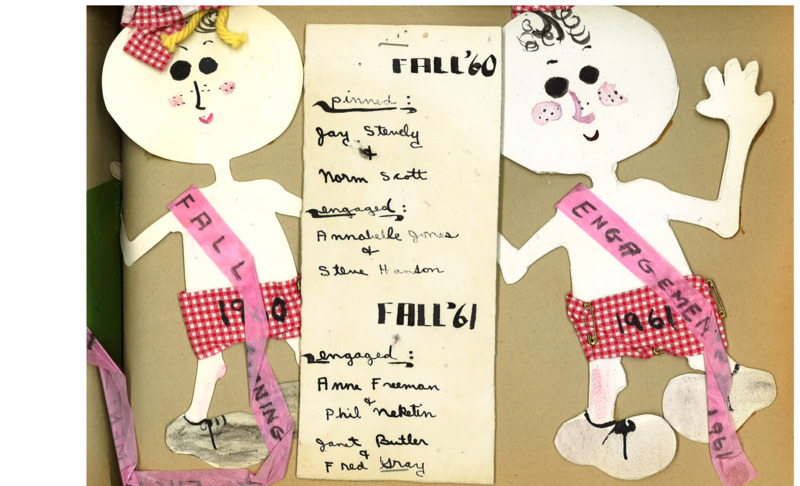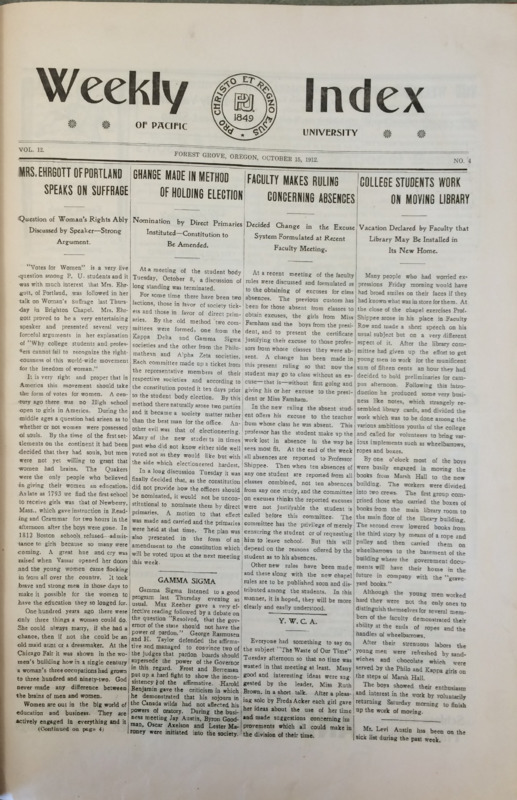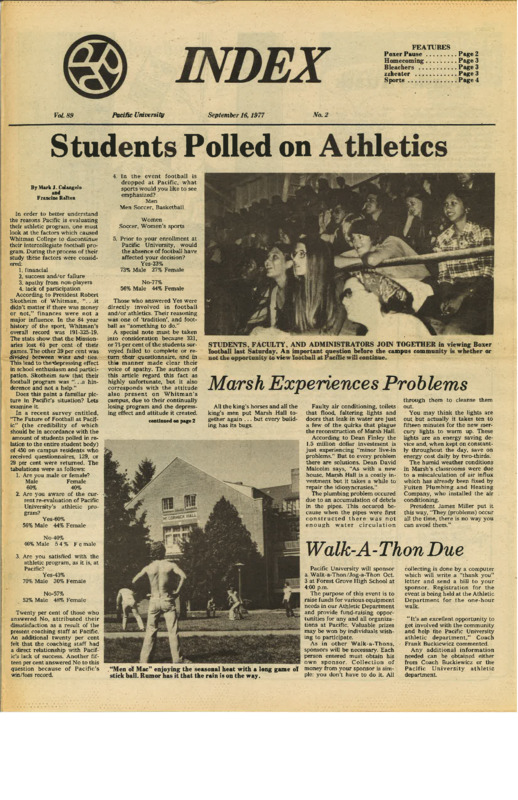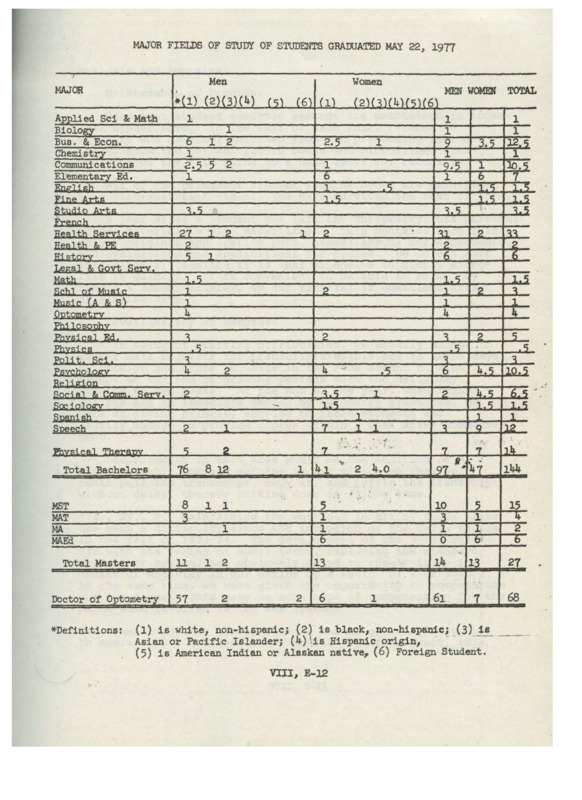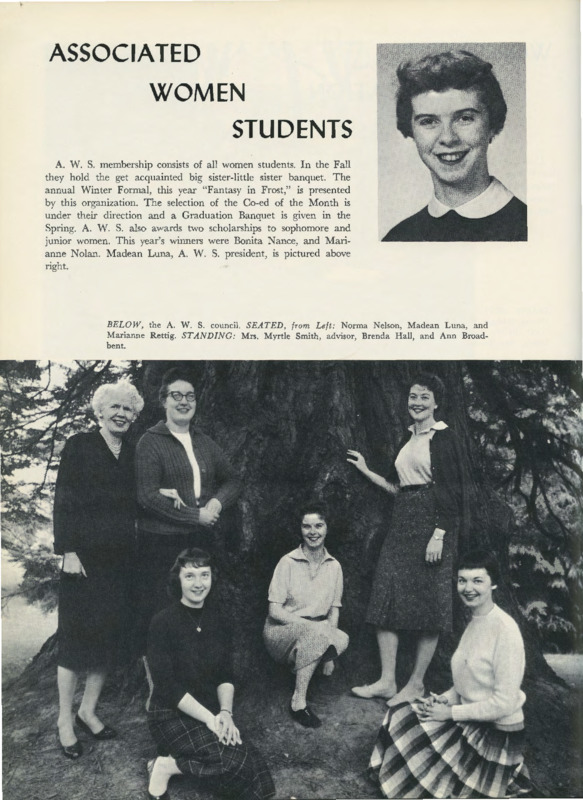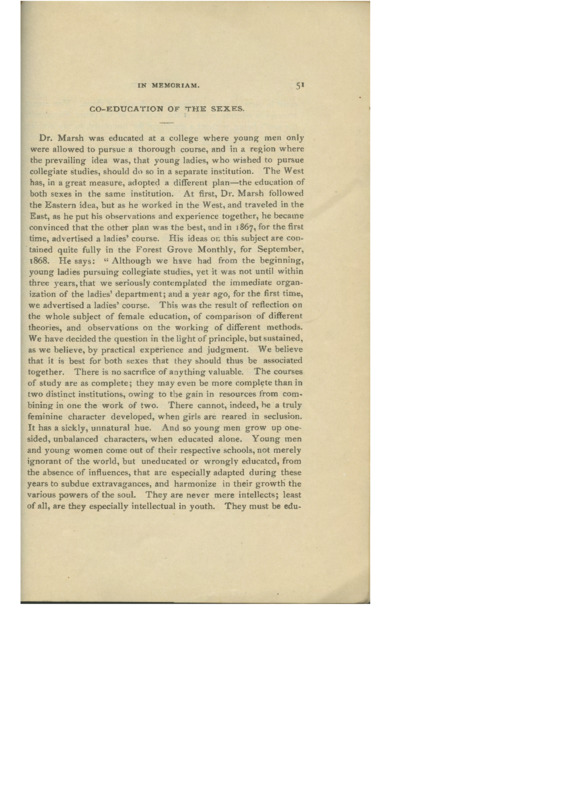Women's History at Pacific
- Title
- Women's History at Pacific
Items
-
Conservatory Music ClubsThis is one part of a document that focused on the Conservatory Music Club, along with other music clubs that were on campus. The Conservatory Music Club wanted to focus on developing musical skills while continuing to learn academically. Other clubs consisted of the Ladies' Glee Club. which continued to grow and develop until they even started going on tours.
-
Elizabeth Miller PassageThis passage is about Elizabeth Miller, one of the first 5 woman teachers in the latter part of 1851. Elizabeth Milller moved to Forest Grove from Vermont, and details he journey to a friend. That section is cut out and put in this memoir as memory. Little is known about Elizabeth Miller or her teaching style, but it is important to look at this document because she was the first. She laid the ground work out for teachers after her. The thing to note though is as soon as she got married, she left teaching. This is what there is not much known. Many women leave their job, and do not come back to the cutthroat place of academics.
-
1997 Pacific University Self-Study Reports ExcerptThe Pacific University Self-Study Reports are a series of decennial reports that lay out University goals, collect and interpret data related to student admissions, graduations, faculty size increases, university finances and more. The reports can act as a valuable measure of race and gender related issues both in what they directly say and what is left out. In the 1997 Report, racial and gender diversity are approached more thoroughly in words than in previous decades, however there is no reported statistical breakdown of racial groups as there was in the 1977 reports. However, Diversity was established as a Strategic Goal (#10, p. xviii). Gender and ethnic diversity statistics were considered as an important component for Residence Life student staffing (IX-244), and a section (IX-280-286) is devoted to an overview on Diversity Services, the Office of Multicultural Services (which began in 1990) and the Office of Disability Studies. One expressed concern was a decrease in black students and males overall because of the dissolution of the football program. This directly counteracted University efforts to maintain a 50:50 balance of male:female students.
-
YWCA ConstitutionThe YWCA is a constitution regarding the women's club on campus. The YWCA was club just specifically women which began in the late 1800's. This constitution explained the different academic achievements that would have to be required to become part of this club. It also goes into detail about how the women will be expected to attend Bible studies and learn about their own faith.
-
Cheron Mayhall 1962 Scrapbook PagePut together by Cheron Mayhall née Messmer in one of her many scrapbooks, this page is dedicated to the commemoration of Susan Ann Lindgren's marriage to Dale Barclay Dawson. As Susan's bridesmaid, good friend, and fellow Pacific University student, Cheron was in the unique position to not only archive the events of the June 1st wedding, but also the post-wedding correspondence sent to her from Susan and Dale. In the upper left-hand corner of the scrapbook page is Cheron's initial invitation to the Lindgren-Dawson wedding, sent by Mr. and Mrs. Lindgren; the newspaper clipping announcing the marriage of Mr. and Mrs. Dale Dawson is tucked inside the card. Under the wedding invite lies the invitation to the wedding breakfast hosted by the groom's parents at the Town and Country, with a matchbox from the restaurant glued next to it. The upper right-hand corner of the page is taken by a thank-you card from the new Mrs. Susan Dawson to Cheron, thanking her for participating in the wedding ceremony and for coming to the wedding shower thrown by the other bridesmaid (Alex Allen). Immediately underneath the thank you note is a letter from Susan and Dale to Cheron, updating her on life as a newly married couple (the word 'Fine' is used more often than not to describe how things are). The bottom right envelope contains a quick note updating Cheron on how the honeymoon went; the envelope also holds a folded postcard from during the Dawsons' honeymoon, with the explanation being that they both had forgotten to send it while actually on the trip. Above the honeymoon letter Cheron pasted the ribbons and butterfly ornament that wrapped around the stems of her nosegay. In the bottom left-hand corner lie an embossed napkin from the wedding reception ('Susan and Dale' on the first line, 'June 1, 1962' on the second), accompanied by a small mesh bag partially full of very old rice grains originally mean to be thrown over the wedding party.
-
Abstract of Title for land once owned by Harvey and Emeline ClarkeAn abstract of title describing the chain of ownership for a parcel of land in Forest Grove, Oregon. The earliest owners named in the abstract are Harvey and Emeline Clarke, two of the earliest Euro-American settlers of Forest Grove. The parcel described in this abstract on a block on the southwest side of downtown, at what is now 1918 A. St. The abstract compiles details from the title history of the land parcel, providing evidence about who owned the land over time. The first recorded owners were Harvey and Emeline Clarke, who had a Donation Land Claim. The Clarkes sold a portion of their claim for $1 to Tualatin Academy, probably intending it to be part of the land endowment of the school. The heirs of the Clarkes then provided a quit-claim deed to Tualatin Academy / Pacific University, which confirmed the donation. In 1873, the Pacific University President and other families connected to the University donated the block of land containing this address "to public use and benefit," apparently in order to provide land for the development of the town of Forest Grove. Following the chain of ownership statement, there is a description of the overall boundaries of the original Clarke claim. The abstract ends with a covenant pertaining to some of the Clarkes' land, which prohibited "ardent spirits" (i.e. hard liquor) and gambling on the premises. This abstract was probably created in the early 1900s, but texts excerpted within it date from 1851-1873.
-
Pacific University earliest written student rosterThis was the earliest written student roster for Pacific University. It appears the names were divided among classes and location. Therefore, many of the names were repeated. This is important because it gives an idea of how many females were attending Pacific University. It also shows what they were given as an education.
-
'Brimfield Heroine' account of Tabitha Brown's journey on the Oregon Trail and the founding of a school in Forest GroveA transcript of a letter by Tabitha Brown describing her overland journey to Oregon in 1846 at age 66, as well her founding of a school in Forest Grove in the late 1840s. The school, Tabitha Brown's 'Orphan Asylum,' would later become Tualatin Academy and Pacific University. She wrote the letter to her brother and sister who were living on the East Coast in 1854. It was later printed as an article under the title 'Brimfield Heroine,' in reference to her hometown of Brimfield, Massachusetts. Tabitha Brown's account includes: leaving Missouri in 1846 with her brother-in-law Captain Brown, her son Orus Brown, and other relatives; Tabitha Brown departing from the standard route via the Columbia River and instead following the Applegate Trail via Utah and California; suffering hardships in the desert and losing nearly all her possessions; arriving in the Umpqua Valley in winter; nearly starving while passing through the mountains; arriving in Salem on Christmas Day, 1846; making some money by sewing buckskin gloves; moving to West Tualatin Plains (now known as Forest Grove) where her son Orus Brown had claimed land; with help from former missionaries Harvey and Emeline Clark, opening a school for local and orphaned children known as Tabitha Brown's Orphan Asylum; the Orphan Asylum becoming a college (first under the name Tualatin Academy, which offered classes through the high school level, with college classes under Pacific University being offered several years later); becoming a prosperous homeowner in Forest Grove while in her 70s; a description of the lands and farms around Forest Grove by 1854.
-
Students Newspaper on Basketball TeamThe Pacific University Index newspaper during 1904-1905 was compiled of 3 different articles involving women's basketball. The newspaper was mentioning how women's basketball was doing, the new rules that were applied, and about a game on how the women did. The article during November 15, 1904 discussed the preparation that women were doing such as basketball practices. It was an overview about women's basketball. The next article on January 24, 1905 was about a ruling at Pacific that was going to be applied in women's basketball. Men were excluded from attending the basketball games. There seemed to be an issue with women being proper while playing basketball publicly in front of men. Finally the last article on February 28, 1905 was about the first inter-class games between the girls. The details of the game was that the game was between the 4th year class versus the 3rd year class. The 3rd year team was compiled of: Ellen Brobst, Maverne Templeton, Jessie Hoge, Martha Holmes, and Everlyn Wing. The 4th year team included: Helen Chandler, Reba Hoffman, Laura Brock, Caroline Brown, and Mary Abenethy. The final score was 11-2 with the 4th year team winning the game. The only males that were allowed to go to the game were the male officials. The information was very significant because despite giving women an opportunity to play basketball it was still a set back because they could not play in front of their male peers. This issue is very unique because it was a rule that Pacific implemented for just women's basketball for their games. There were no rules prohibiting women to watch men's basketball, so it shows the inequality women still dealt with. This rule did not last too long, but for such a rule to be considered shows how difficult it was for women's athletics to be recognized equally. There was a major difference between male and female athletics and this rule shows a major distinction between the two. Women athletics during the 1900's had many negative qualities, but this era was the early years of women's sports and gave women the opportunity to play collegiate sports.
-
'Equal Rights for Women Athletes' IndexThere was a Women Athletic Association (W.A.A) at Pacific University that was involved with women's athletics. Anne Wagner wrote an article within the Index Pacific University newspaper to the editor Wesley Sherman. She wrote about the lack of acknowledgement that women were receiving from their athletic accomplishments. This piece was not only found in the Pacific University Index newspaper, but also within a scrapbook created by the W.A.A. during 1937-1938. The W.A.A supported women's athletics and had their own cabinet. The members included: President: Winifred Fortner, Vice President: Jean Allin, Secretary: Doris Deemer, and Treasurer: Georgena Potts. There were even Heads of Sports and the writer of the newspaper article, Anne Wagner, who was also the head of tennis. The other head of sports included: Volleyball: Mary Rockwood, Basketball: Irene Redetske, Baseball: Allene Wilson, Archery: Hazel Stook, and Golf: Doris Gregg. This group was a major importance to the women's athletics at Pacific University. It was created post Title IX, but it shows the progress in how a group wanted to create a difference in women's sports. The article described the amount of work women had to do in order to receive a jacket. There were so many qualifications that women had to achieve in order to receive the honor such as: pass a knowledge test with an 80%, pass a practical skills test at 90%, participate in 3 team sports, 4 individual sports, and 1 rhythmical activity. Women at least did have a choice in their sports. Women had to choose 3 out of the 5 team sports that included: hockey, speedball, volleyball, baseball, and basketball. Then their individual sports had to choose 4 out of the 7 such as: swimming, tennis, archery, hiking, golf, badminton, and ping pong. Then finally they had to choose 1 out of the 4 rhythmical activities such as: folk, tap, social, or modern dancing. There were so many things women had to do in athletics just to be recognized, but they still lacked the support. This program was very significant for women's sports and pushed the issue for women to be valued in what they have done in athletics. They were the voice for women athletes at Pacific University when the article was published. This article pushed for an idea that women deserve that recognition. This group pushed the issue for women athletes to be valued and recognized and that is why it is so significant. This was about 30 years prior of Title IX being passed, but the W.A.A group at Pacific University still was in pursuit for that equality in recognition for women's sports.
-
Athletic Program ReportA report that was created by the President's Committee on Athletics on February 15, 1978 about Pacific University's athletic program. This report was sent to the Pacific University President, Dr. James V. Miller. The committee was composed of both faculty and students which included: Dr. Marshall Lee, Dr. Frank Buckiewicz, Dr. Miles Shishido, Dr. H. Joe Story, Kris Chatari, Cindy Dix, David Wolf, and Robert Slauson. The student members within the committee were involved in the athletic program at Pacific University and student life during 1977-1978 such as: Kris Chatari was a volleyball player, Cindy Dix was a soccer player, David Wolf was a part of the Game Sigma Frat, and Robert Slauson was a football player. Faculty member Dr. Frank Buckiewicz was also heavily involved in the athletic program as he was one of the football coaches for Pacific University. This diverse group of members allowed for different perspectives on the issues at hand within the athletic program. There were twenty sessions of these meetings from September to February. Students were able to provide insight on the athletic program because they were personally involved and participated. The faculty members provided their own opinions on how the athletic program was doing. The report was initiated when Whitman College in 1977 dropped their football program, so the Pacific Northwest Intercollegiate Athletic Conference required all schools to conduct their own study on their intercollegiate athletic programs. Pacific University conducted their report and based off this document there were quite a few issues despite the role of Title IX. Students and faculty voiced their concerns and that was the role of this document. Within the document there were a few discrepancies based on the information that was presented. During 1976-1977 the statistics presented within the report had some issues with equality in sports. There were budget issues between men and women sports. Based on the report it stated that for women it was 19.18% of costs in athletics whereas in male sports budget it was 80.82%. That is a wide gap between how much money is being put into the programs based on gender, so that was a major issue even after the passing of Title IX. Money was not the only issues within women's athletics, but also the qualifications of coaches that were being hired in women's athletics were questioned. Many female athletes voiced their opinions about their coaches being unqualified. There were other remarks throughout the report such as wanting more female coaches. Not only were coaches an issue, but women were not given the luxury to travel and experience competition as much as the men were in the athletic department. That was a major point mentioned despite the changes within the United States to provide better opportunities for women in athletics. Women, men, and faculty within the committee described the need for change in the athletic department for Pacific University to be successful. Some of the other main points were more equipment, more coaches, equal opportunity in athletics, more travel arrangements, and achieving growth and development. This report allowed for Pacific University to reflect on the athletic department and the role it has played with equality. Even after Title IX was passed it shows that there were still issues with equality with women in athletics despite the political changes throughout the country. This report was a major significance because it is confronting the issues within their own department. This report acknowledges what needs to be fixed within the athletic department especially for women's sports and provides ideas on how to improve the athletic program.
-
First Advertisement for Pacific UniversityTranscript of a circular letter authored by Dr. George H. Atkinson, advertising the creation of a new “collegiate department” at Tualatin Academy in Oregon. Tualatin Academy was a secondar school; its new collegiate department would be called Pacific University. Copies of the letter, which was endorsed by the Trustees of Tualatin Academy, was taken to the East Coast by Atkinson and used in fundraising. Atkinson was active in promoting various educational, missionary and development projects in Oregon and had many contacts in the East. A notable feature of this advertisement is that it only mentions serving male students at the new college, even though women would be admitted there. This transcript appeared in a typescript history of Pacific University and Tualatin Academy that was written around 1900.
-
Atkinson's (Secretary of Board of Trustees) views on Female Education at Pacific (Unfinished)Atkinson sees female education at Pacific University as much needed. He desires to see the education of females and males happen in the same level, or the co-education of both groups as near equal to one another. It is not addressed to which extent that Dr. Atkinson desired the education of women, just that it was important to educate them, so that they could become more important to the society as a whole. This document is written for someone on the west coast, where females and males were more on equal grounds. Another document in this archive is written for the east coast of the United States, where Dr. Atkinson does not address the presence of women at the early Pacific University. That is not the case in this document.
-
Constitution and By-Laws of Herrick Hall, Student House Government Association of the Women of Pacific UniversityThis is a copy of the Constitution and By-Laws of Herrick Hall printed in The Weekly Index at Pacific University on March 24, 1914. It is stated that the purpose of the constitution was to control all matters pertaining to women living on and off-campus (excluding those who lived with parents or guardians), making and enforcing rules, and to further the interests of the women. All women who attended Pacific University were required to live in a residence hall on-campus unless given special permission with other living situations regarding parental or marriage supervision. The constitution describes the different roles and their respective duties that were made each year by each of the halls: a President of the Hall (who would also reside as the President of the Association), a Vice-President of the Association, a Vice-President of the Hall, a Secretary-Treasurer of the Association, a Secretary-Treasurer of the Hall, a Chairman of the Off-Campus committee, many different Proctors for each section of the hall, and a Head Proctor. There was sometimes also a Temporary Chairman who served when the previous year's chairman graduated. The committees that were put together were the House Council, Advisory Board, and an Off-Campus Committee. The By-Laws describes the oaths and agreements each woman followed. The articles include things like: quiet and study hours during the week and relaxed hours during the weekend; no running or walking noisily in the halls, with soft slippers used after 7:30 pm; no slamming of doors; the scheduled time of reception and when guests were allowed to be in the building; men were not allowed at all into the residence hall, with the exception of fathers and sometimes, under rare permission, brothers; women, unless given special permission by the Dean of Women, were not allowed to visit the men's residence hall; the women had to get permission to leave the hall, spend the night outside of their room, and when leaving the school; attendance at social evening events needed permission, while those that were associated with school or school-related clubs and societies were approved without permission; three nights of having a guest were free of charge; women could not ride horseback or drive without an approved accompanist; doctor visits or summons could not be made without permission; each morning, rooms had be cleaned promptly, with the exception of Saturday until 10:30 am; attendance at meal times was expected and on time; lights had to be off between 10 pm and 5:30 am, with Friday and Saturday extended to 10:30 pm; any light on after the designated time had to be reported to their Proctor; evening social events ending after 9:30 pm allowed the women to have lights on for the following half hour; fines were made for any meeting unattended; the House Council had control of any and all disciplinary actions. Any permission that was granted was given by the Dean of Women. Each woman was automatically a member of the Association and was required to attend the regular and special meetings. The Constitution and By-Laws were read at the beginning of the first meeting of each school year and each woman received a personal copy. Amendments could be made to both the Constitution and By-Laws if submitted in writing to the Advisory Board and House Council and then voted on a two-thirds majority at the following Association meeting.
-
1987 Pacific University Self-Study Reports ExcerptsThe Pacific University Self-Study Reports are a series of decennial reports that lay out University goals, collect and interpret data related to student admissions, graduations, faculty size increases, university finances and more. The reports can act as a valuable measure of race and gender related issues both in what they directly say and what is left out. In the 1987, there were no mentions of racial and ethnic diversity as an explicit University goal as there was in the '77 reports. It is also missing a racial/ethnic breakdown of admitted or graduating students. This selection shows a brief description of Pacific's minority recruitment program and its efforts to 'familiarize minority students and their parents with higher education opportunities' and which includes a Minority Pre-College Program that visited high schools to entice minority students.
-
'Minstrels Coming Wednesday Evening' News ArticleAn article on an upcoming minstrel show published in "The Index," the Pacific University student newspaper, on November 26, 1912. From approximately the 1890s to the 1940s Pacific University student groups occasionally hosted minstrel shows as entertainment and/or fundraisers. This article reports that in this year, twenty-five men (mostly students, with at least one professor) would be performing as "Big, black darkies," presumably mostly as singers in a chorus. Six of them (the "end men") were featured performers: students Charles McNeil, Earl House, Tub Shaver, Billy Livingston, Professor Jones, and one "mysterious lady." This particular event was sponsored by the Gamma Sigma fraternity and was held at the off-campus Star Theatre. No African American students are known to have attended Pacific University at the time. Minstrel shows such as this one normally included white people wearing blackface, singing and telling jokes denigrating black slang and intelligence. They relied on stereotypical racist depictions that were harmful to African Americans.
-
Cheron Mayhall Letter To Mother Asking for Cookies for Gamma Sigma FraternityA letter written by Cheron Mayhall on September 24, 1963 to her mother concerning the making of cookies for the Gamma Sigma fraternity. Cheron was part of the Theta Nu Alpha Sorority at Pacific in the 60's and they were affiliated with the Gamma Sigma Fraternity. At Pacific it was common place for Fraternities and Sororities to be affiliated with each other as brother-sister and these connections still exist today at Pacific. Cheron is asking her mother to make cookies for the Gammas as a gesture of good faith as it seems she had declined the opportunity to become the Gamma Sigma House Mother. Cheron even instructs her mother to keep a 'place of honor just incase Gammas grab boxer next time around.' Cheron here is referring to the 'Boxer toss' which was a brawl that took place between fraternities and other campus groups to seize the Boxer Statue that is now the mascot of Pacific. This letter shows how the fraternities were viewed and treated by the sororities who seemingly just did things like bake cookies and supported them in the Boxer Toss from the sidelines. This document is from a collection of photocopies of Cheron Mayhall's letters from her time at pacific.
-
Delta Chi Delta 'Pinned & Engaged' Scrapbook PageA page from the 1960-1961 scrapbook from the Delta Chi Delta sorority at Pacific University. Delta Chi Delta was founded in 1959 and was active on campus at Pacific into the 1980's when it was disbanded. The sorority renewed it's charter in 2001. This scrapbook page has a list of sorority women had either become 'pinned or engaged.' Pinning was a sort of pre-engagement ceremony where a fraternity brother would give his fraternity pin to his girlfriend in a sorority. the page has lists for both Fall semester of 1960 and Fall semester of 1961.
-
Weekly Index of Pacific University: Mrs. Ehrgott of Portland Speaks On SuffrageThis is a 1912, Pacific University Index Article. It talks about the speech of the leader Mrs. Erhgott, whom speaks upon the subject of women's suffrage. She describes the rights of women as something that was gained over time. Mrs. Ergott used the arguments of Medieval scholars debates of women having souls, talks about the Quakers being the only religious group in the early United States giving women the right to vote, and then goes into the subject of the Boston school system shutting its doors to women in 1812, and how by this point women finally argued against their separation from education. In 1912, Mrs. Erhgott compelled a crowd to consider also giving women the right to vote. As she argues, many women were already starting to go into the public business world and 17 percent of high school graduates come from high school. She further argued, that it would only be fair to let women have the right to vote, because women who are educated do make society better, and excluding them would exclude an significant portion of the population from having a say in society. At the time, there existed a anti-womens suffrage movement to counter her. They believed that when women received the right to vote, that they would not use the right to vote. Her speech countered their objections by attracting a large crowd interested in her speech.
-
'Students Polled on Athletics' IndexThis item is a newspaper article that came out of the Index of Pacific University about the students polling on athletics. The writers of the article was Mark J. Colangelo and Francine Raften. The article was written in 1977. The article subject is about the issues that students saw in the athletic program. In the polling process it is very evident that women were very unsatisfied with sports at this time. Interesting enough this is 5 years after Title IX was passed, so it would seem that not much has changed in response, even though women were participating in sports during 1977. Women were involved in competition, participating in sports, and were part of a team. Women were involved in gymnastics, soccer, tennis, track, volleyball, and even basketball. There were equal to men, but even after the passing of Title IX women were still unsatisfied at Pacific University. The polling article greatly stressed the percentages of the polls and how 70% men were satisfied with the program whereas women were 30% satisfied. This article is significant because even after the pass of Title IX where women are suppose to equal to men in athletics, there were still issues for women. This entails how long the process was for women to be recognized fairly in the same light as men and gaining the respect of being a female athlete. This article is very significant because it shows retrogression in Title IX instead of progress at Pacific University based on the polling results of the athletic program.
-
1977 Pacific University Self-Study Reports ExcerptsThe Pacific University Self-Study Reports are a series of decennial reports that lay out University goals, collect and interpret data related to student admissions, graduations, faculty size increases, university finances and more. The reports can act as a valuable measure of race and gender related issues both in what they directly say and what is left out. The 1977 reports expresses racial and gender diversity as a main goal for the University. Specifically, this is expressed a 'maintain[ing]' an 'ethnic and social and coed mix of [the] student body.' On the twelfth page of the introduction attention is drawn to Black Culture Week and the Hawaiian Luau which are considered 'grand celebrations' of minority culture. Having an excess of 20% of students as minorities is considered an indication of achieving University goals. Rather than expressing a goal to diversify the mix of students, or increase acceptance of minorities, the goal is explicitly to 'maintain the mix'. Section VIII, E-12 shows the number of graduating students in May '77 broken down by major field of study, gender and racial background. This was the first time race and ethnicity was reported in these self-studies, but this practice would not be followed in the '87 and '97 reports. The documents featured show important statistics about the portion of women undergraduate and graduate students who were minorities.
-
Associated Women Students 1959 Yearbook PageThe Associated Women Students 1959 yearbook page shows their Spring 1959 President, Madean Luna, as well as the A.W.S council, which included their adviser Mrs. Myrtle Smith. A.W.S. also selected a co-ed of the month as well as a co-ed of the year. The selection was based on achievement and involvement on campus. This page was taken from the 1959 Yearbook from Pacific University, Heart of Oak.
-
In Memoriam. C0-Education of the SexesThis is the section of a Memoriam book for Dr. Marsh, whom died two years before the publishing date in 1879. The book describes how he changed the school's education system from not teaching female students, to teaching female students. While observing different teaching methods from different regions, he found that the society seemed to function better when both men and women were being taught in a similar environment, rather than separate from each other. The trustees, agreed that it was important to keep the humanity with the males sane and that having women in the school environment would be beneficial in general. Young Women were still considered to be famine rather than noble still within the eyes of the University trustees. For they did not consider the approval or thoughts of women when it came to this decision or even consult with women on the educational synopsis developed for women.
